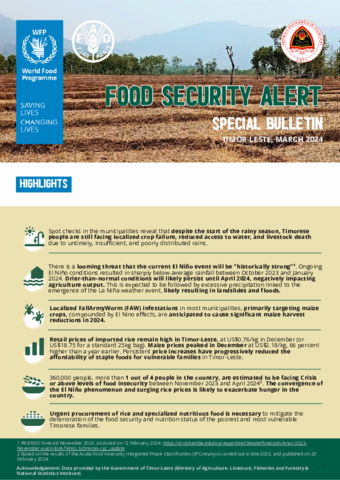
It charts the particular risks presented by El Niño in the light of Timor-Leste’s current levels of acute food insecurity and its reliance on rain-fed agriculture.
It identifies a series of recommended actions as well as information from the field.
Spot checks in the municipalities reveal that despite the start of the rainy season, Timorese people are still facing localized crop failure, reduced access to water, and livestock death due to untimely, insufficient, and poorly distributed rains.
There is a looming threat that the current El Niño event will be “historically strong”. Ongoing El Niño conditions resulted in sharply below-average rainfall between October 2023 and January 2024. Drier-than-normal conditions will likely persist until April 2024, negatively impacting agriculture output. This is expected to be followed by excessive precipitation linked to the emergence of the La Niña weather event, likely resulting in landslides and floods.
Localized FallArmyWorm (FAW) infestations in most municipalities, primarily targeting maize crops, compounded by El Nino effects, are anticipated to cause significant maize harvest reductions in 2024.
Retail prices of imported rice remain high in Timor-Leste, at US$0.76/kg in December (or US$18.75 for a standard 25kg bag). Maize prices peaked in December at US$2.18/kg, 66 percent higher than a year earlier. Persistent price increases have progressively reduced the affordability of staple foods for vulnerable families in Timor-Leste.
360,000 people, more than 1 out of 4 people in the country, are estimated to be facing Crisis or above levels of food insecurity between November 2023 and April 2024. The convergence of the El Niño phenomenon and surging rice prices is likely to exacerbate hunger in the country.
Urgent procurement of rice and specialized nutritious food is necessary to mitigate the deterioration of the food security and nutrition status of the poorest and most vulnerable Timorese families.


